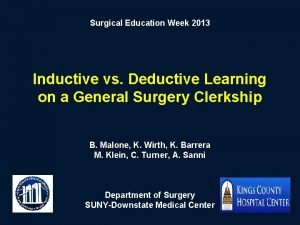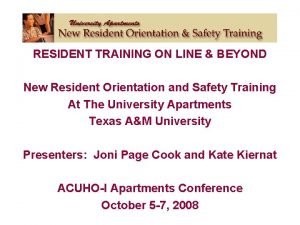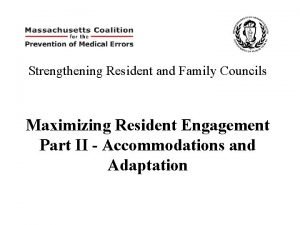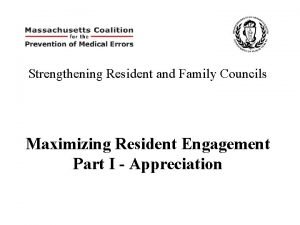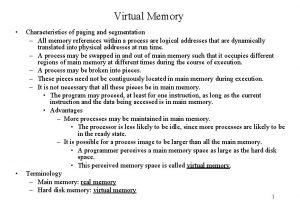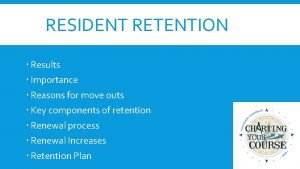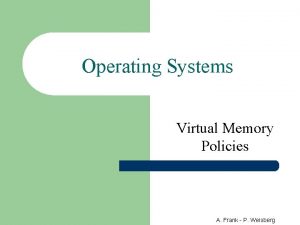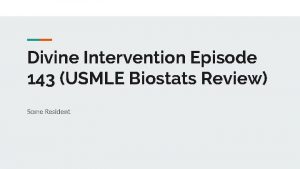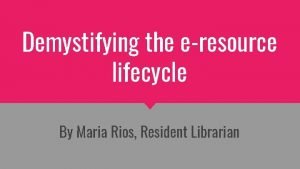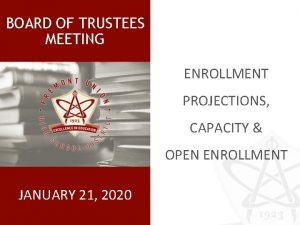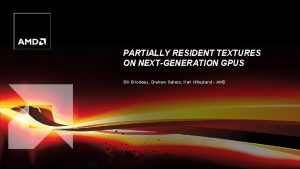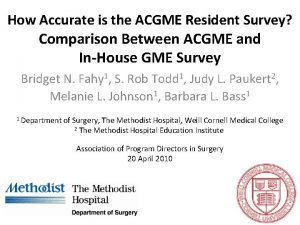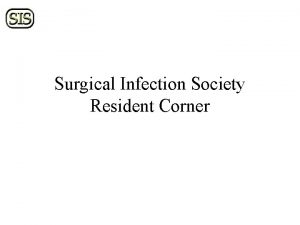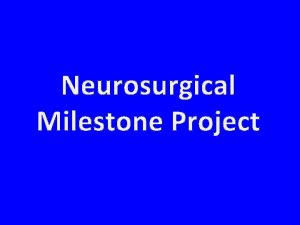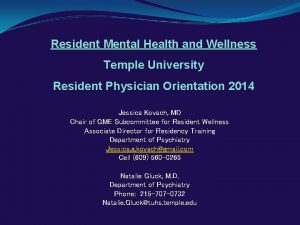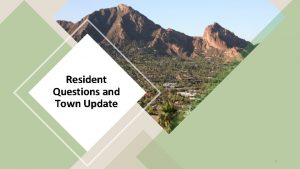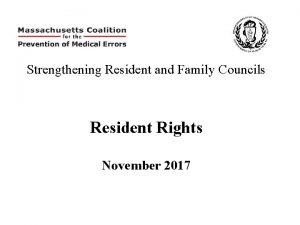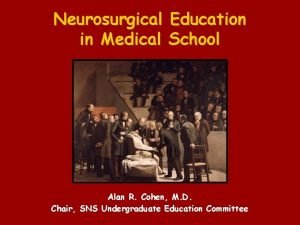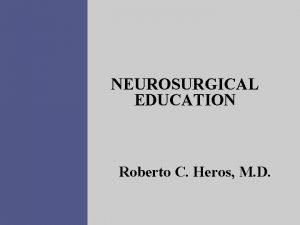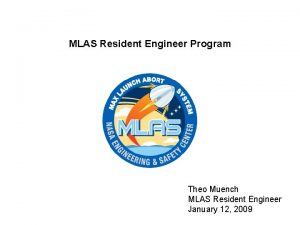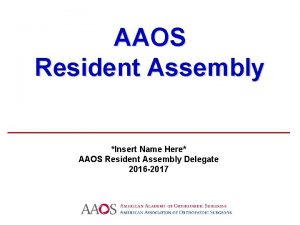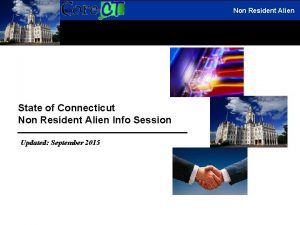The First Year Neurosurgical Resident Surgical Education and



















- Slides: 19

The First Year Neurosurgical Resident: Surgical Education and Outcomes M. Christopher Wallace M. D. Division of Neurosurgery Department of Surgery University of Toronto

Disclosures o o No Financial Disclosures I work in Canada…where DH means Designated Hitter, not Duty Hours

Objectives o o o Poke fun at how we train PGY 1 s currently List the opportunities and benefits of improving the training Predict the challenges of evaluating training

Entering Neurosurgery o o o Undergraduate degree (3 -4 yrs) Medical Degree (4 yrs) Application in final year Neurosurgery electives Sophisticated selection process Matching Service Arrive at your program…. . hopefully ready to “work”

1 st Year Neurosurgery Residents o o Not youngsters…hard to call them students Sometimes appear more confident than some of your residents Energy and enthusiasm Neurosurgically naive

Neurosurgical Curriculum o o o PGY 1/2 Core Curriculum Foundations of Surgery Try to get them on service as much as is allowed Left to the Senior/Chief residents Schedule their call obligations

Importance of PGY 1 Experience o o Learning Safety Exposure to all great aspects of Neurosurgical practice……not just the junior side of life…ie ward or the ER They have decided on Neurosurgery …and you have decided on them…very early so initial opportunity to evaluate their and your decision

Breadth of training o o o History and examination of patients Radiological investigations Diagnosis and treatment decision making Core competencies of practice Professionalism …………. but their focus (and ours) is their surgical training

Rotation Specific Objectives o o o At the completion of their neurosurgical rotation, junior neurosurgery residents at TWH will have demonstrated a basic understanding of neurosurgical anatomy, and the technical ability to satisfactorily and safely perform the following procedures: Burr holes for drainage of subdural hematomas and empyemas Ventriculostomy Insertion of ICP monitor Craniotomy for trauma, tumour, stroke, and infection (including posterior fossa craniotomy) Application of Halo ring and the use of cervical spinal traction

Rotation Specific Objectives o o o At the completion of their neurosurgical rotation, junior neurosurgery residents at TWH will have demonstrated a basic understanding of neurosurgical anatomy, and the technical ability to satisfactorily and safely perform the following procedures: Cervical dissection for carotid endarterectomy and anterior cervical fusion. Posterior cervical, thoracic and lumbar spinal exposures for trauma and degenerative diseases. Lumbar puncture Exposure of median and ulnar nerves for neuropathy Nerve and muscle biopsies

Rotation Specific Objectives o o o Under the supervision of the staff neurosurgeon, the senior resident or clinical fellow, the neurosurgical resident at the junior level at TWH will assist at various levels in the completion of the following procedures: Supratentorial craniotomy for traumatic head injury and removal of extradural hematoma, subdural hematoma, and intracerebral hematoma Supratentorial craniotomy for tumor removal, including some intradural surgery Craniotomy for aneurysm repair or AVM excision Exposure of cervical and lumbar discs Placement of VP shunts

Surgical Responsibility: Learning as an Apprentice o Progressive responsibility n o o o PGY 1 to senior resident Disclosure to patients Time and Resource Constraints Morbidity

Surgical Experience PGY 1 Residents o o Survey of first yr residents From programs with >11 residents 88% 3 months neurosurgery in 1 st yr 78% Access to cadaver, animal or simulation laboratory 88% Fallah A et al Surgical activity of first-year Canadian neurosurgical residents. Can J Neurol Sci. 2010 Nov; 37(6): 855 -60.

Surgical Experience PGY 1 Residents o Number of operations n n n o o Primary surgeon 12 (± 5. 4) 1 -16 Assistant 53 (± 15. 5) 29 -79 Total 66 (± 14. 9) 46 -85 Intracranial hemorrhage, tumor, CSF diversion Importance to residents Fallah A et al Surgical activity of first-year Canadian neurosurgical residents. Can J Neurol Sci. 2010 Nov; 37(6): 855 -60.

Boot Camp for 1 st year Residents o o Didactic lectures Practical skills: ventriculostomy, burr holes, lumbar puncture, ICP monitor Provide level baseline skills Supervised training Selden N, Barbaro N, Origtano TC, Burchiel K Fundamental skills for entering neurosurgery residents: report of a Pacific region "boot camp" pilot course, 2009. Neurosurgery. 2011 Mar; 68(3): 759 -64

Boot Camp for 1 st year Residents o Feedback: topics wanted n n o o How to be a good resident The crashing neurosurgical patient Provide level baseline skills Supervised training Selden N, Barbaro N, Origtano TC, Burchiel K Fundamental skills for entering neurosurgery residents: report of a Pacific region "boot camp" pilot course, 2009. Neurosurgery. 2011 Mar; 68(3): 759 -64

Evaluation: CANMEDS Competencies Professional Medical Expert Communicator Collaborator Health Advocate Manager Scholar

Training Evaluation o o o ITERs…. subjective/instructors’ role Examinations Challenge of surgical skills evaluation n n o Direct observation Competency based curriculum Simulation evaluation

Summary o o Opportunities for improving training and evaluation of junior residents in Neurosurgery Importance of faculty supervised training
 Surgical education week
Surgical education week Orientation and resident rights quiz
Orientation and resident rights quiz Resident citizen
Resident citizen Resident and family engagement
Resident and family engagement Resident and family engagement
Resident and family engagement Poem for y6 leavers
Poem for y6 leavers Resident set management
Resident set management Resident retention
Resident retention Resident set management
Resident set management Divine intervention usmle
Divine intervention usmle Resident lifecycle
Resident lifecycle Chapter 2 foundations of resident care
Chapter 2 foundations of resident care Attending vs resident
Attending vs resident Examples of misappropriation of resident property
Examples of misappropriation of resident property A helpful way for an na to respond to hallucinations is to
A helpful way for an na to respond to hallucinations is to When ambulating a resident should be wearing
When ambulating a resident should be wearing Partially resident textures
Partially resident textures Acgme resident survey
Acgme resident survey Employment of non-resident aliens in the philippines
Employment of non-resident aliens in the philippines Customer service conflict resolution
Customer service conflict resolution
